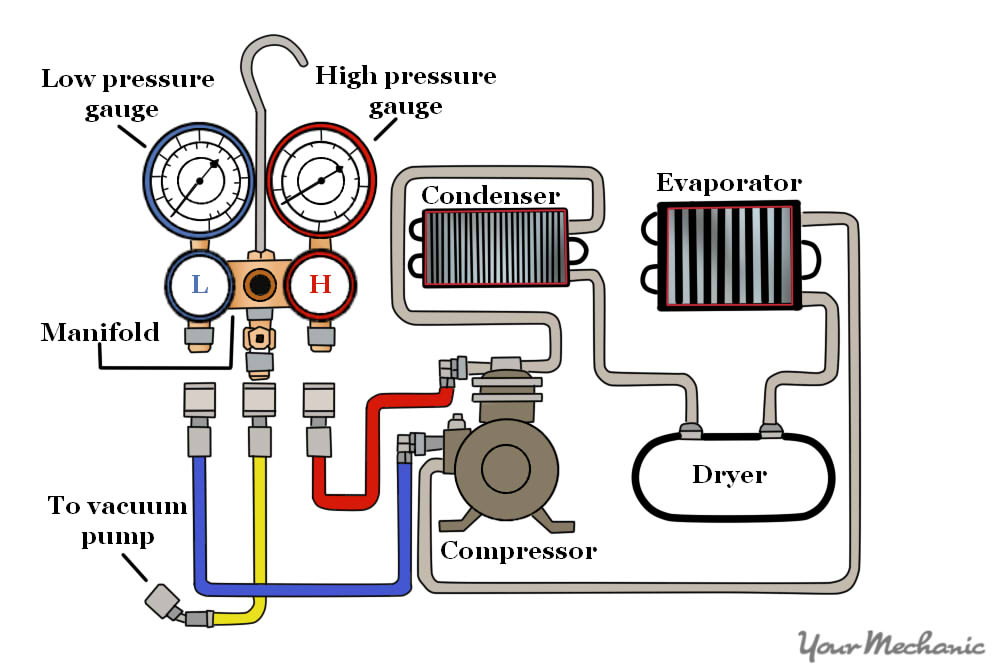To remove air from an AC system without a vacuum pump, you can use the compressor itself to pull the system down to a vacuum. Open the low side valve and run the compressor to begin this process.
Removing air from an automobile’s air conditioning system is crucial for its efficient operation. A vacuum pump typically achieves this, but not everyone has access to such a tool. Car enthusiasts and DIY mechanics often seek alternative methods to achieve a well-functioning AC system without this specialized equipment.
The method involving the compressor as mentioned provides a practical solution. It involves a process known as ‘sweep charging,’ which can help purge the air and moisture by utilizing the system’s own components. This maintenance task is essential for those wanting to avoid the cost of professional equipment while ensuring their vehicle’s AC runs cool and efficiently. For a successful outcome, it is vital to follow a precise set of instructions and take appropriate safety precautions during the procedure.

Credit: americanhomewater.com
Introduction To Ac Systems And The Importance Of Removing Air
An air conditioning system is crucial for comfort in homes and cars. It is essential to remove air from the system to ensure it works well. Air blocks proper refrigerant flow and reduces cooling efficiency. That is why the AC system needs care.
Understanding The Basics Of Air Conditioning Systems
Air conditioning systems work by moving refrigerant through coils. This process absorbs heat from the inside and expels it outside. Key AC system parts include the compressor, condenser, expansion valve, and evaporator.
The Impact Of Air Contamination In Ac Systems
Air and moisture in an AC system can cause corrosion and damage. They reduce system efficiency and can lead to higher energy costs. Removing air and moisture is vital for a healthy AC system.
Why A Vacuum Pump Is Commonly Used And Its Alternatives
A vacuum pump removes air and moisture from an AC system. It is the standard method used during installation and repairs. But, alternatives exist for removing air without a vacuum pump. These alternatives include the “push-pull” method, using a refrigerant to purge the system, or the manual compression technique.

Credit: m.youtube.com
Signs Indicating Air Presence In The Ac System
Your car’s AC system works best when it’s closed and free of air. But sometimes, air enters and causes problems. It’s important to know the signs.
Symptoms Of Air Within The Ac System
- Inconsistent cooling: Air pockets prevent proper refrigerant flow.
- Strange noises: Hissing suggests air within the AC unit.
- Lukewarm air: Indicates the AC isn’t cooling efficiently.
- High pressure on gauges: This shows excess air in the system.
How Trapped Air Affects Ac Performance
Air in the AC system can lead to uneven cooling and added strain on the compressor. It also results in inefficiency and higher operating costs.
Tools And Equipment Needed For The Removal Process
| Tool/Equipment | Use |
|---|---|
| Manifold gauge set | Measures AC pressure |
| Wrench set | Opens the AC system |
| Replacement seals | Ensures a tight system seal after the process |
Understanding The Process Of Air Removal Without A Vacuum Pump
Removing air from an AC system is crucial for its proper function. The usual method involves a vacuum pump. But there are ways to do it without one. We’ll explore a manual approach that’s both practical and effective.
The Principle Behind Removing Air Manually
Manual air removal relies on the AC’s compressor. The goal is to create a low-pressure condition. This makes refrigerant flow and pushes air out. You’ll be using the system’s own circulation for this method.
Precautions And Preparations Before Starting The Process
- Collect the right tools: Wrenches, screwdrivers, a refrigerant kit.
- Protect yourself: Gloves and safety goggles are a must.
- Ensure system compatibility: Check the AC manual for any specific precautions.
Safety Considerations When Working With Ac Systems
Safety is paramount. Always wear protective gear. Make sure the AC is powered off. Keep flammable items away. These steps help prevent accidents and ensure a smooth air removal process.
Step-by-step Manual Air Removal Technique
Got an AC system filled with air and no vacuum pump? Worry not. This Step-by-Step Manual Air Removal Technique will help you clear out that unwanted air quickly. Just follow these simple steps and you’ll be on your way to a smoothly running AC system.
Opening The Ac System To Atmospheric Pressure
Before you begin, remember: safety first! Turn off your AC system completely. You need to find the low-pressure service port. It usually has a blue cap and is on the larger diameter tubing. Once you locate it, unscrew the cap.
Utilizing The Natural Properties Of Refrigerants
Refrigerants have a lower boiling point than water. This means they vaporize easily. When you open the low-pressure service port, the pressure inside the system drops. Refrigerants inside will start to turn into gas. This helps push the air out because air stays a gas at low pressure while refrigerants vaporize.
Guiding The Refrigerant Flow To Expel Air
Start the engine, switch your AC to maximum cool and maximum fan. This will make the compressor pump the refrigerant. Keep doors and windows open. You don’t want to breathe in refrigerant. Let the system run for about 15 minutes to ensure the air moves out.
- Ensure the system pressure is stable before you shut off the engine.
- Close the low-pressure port by hand tightening the cap.
- Check if the AC is cooling well.
Remember, a pro should handle refrigerants due to environmental and safety concerns. This technique is a temporary fix, not a replacement for evacuation with a pump. Be safe and considerate of your environment!
Alternative Methods For Air Removal
Removing air from your AC system is crucial for its efficiency. Not having a vacuum pump handy does not mean you cannot achieve this. Let’s explore some effective alternatives to ensure your AC runs smoothly.
Using A Refrigerant Recovery Machine
Sometimes, tools designed for similar tasks can come to the rescue. A refrigerant recovery machine can remove most of the air and refrigerant from your AC system.
- Connect the machine to your AC system’s low and high-side service ports.
- Follow the manufacturer’s guidelines to initiate the recovery process.
- The machine’s internal vacuum will pull out the air along with the refrigerant.
Applying The Compressor Clutch Cycling Technique
This manual method takes advantage of your AC system’s inherent design.
- Start the vehicle and turn on the AC to its highest setting.
- The compressor’s clutch will engage and disengage repeatedly.
- This action can gradually move air out of the system.
Patience is key here, as this method takes longer but costs nothing.
Exploring The Push-pull Recovery Method
This technique is slightly more complex but highly effective.
- The push-pull method creates a force that moves refrigerant and air.
- It requires reversing the refrigerant flow in the system.
- Close the high side valve, and open the low side valve on your recovery machine.
Ensure you understand this method well before attempting it to avoid system damage.

Credit: www.yourmechanic.com
Troubleshooting Common Issues In Manual Air Removal
Removing air from an AC system without a vacuum pump often leads to some issues. These problems need swift troubleshooting. Let’s look at common hurdles during manual air removal and find solutions.
Addressing Incomplete Air Removal
Attempting to remove air from your AC system manually can leave some behind. This impacts system efficiency. Here’s what to do:
- Double-check connection points for tight seals.
- Repeat the air purging process.
- Verify the condenser is upright for optimum air release.
Handling Refrigerant Leaks
Leaking refrigerant is a serious concern. It signals improper air removal. Follow these steps to rectify:
- Inspect hoses and joints for signs of leaks.
- Use a refrigerant leak detector or soap solution.
- Tighten or replace faulty components.
Ensuring System Integrity Post Air Removal
Once air removal is complete, maintain system integrity. Check the system’s performance. Observe:
| Parameter | Action |
|---|---|
| Pressure Gauge Readings | Monitor for stable pressure. |
| Cooling Efficiency | Assess temperature drop. |
| Noise Levels | Listen for unusual sounds. |
Conclusion And Best Practices
Removing air from an AC system without a vacuum pump is a delicate process. Let’s recap some of the best approaches to maintaining an air-free AC system, when to seek professional help, and the long-term benefits of regular upkeep.
Maintaining An Air-free Ac System
- Follow the manual: Refer to your vehicle’s service manual for specific guidelines.
- Use the right tools: Equip yourself with quality manifold gauges and hoses.
- Check for leaks: Ensure all connections are tight to prevent air ingress.
- Regular checks: Monitor your AC system’s pressure regularly.
When To Seek Professional Assistance
Complex issues or uncertain scenarios demand expert care.
Qualified technicians can safely and efficiently handle the task.
Long-term Benefits Of Proper Ac System Maintenance
| Benefit | Description |
|---|---|
| Efficiency | Regular maintenance keeps your AC running smoothly. |
| Longevity | A well-maintained system lasts longer, saving money. |
| Comfort | An air-free system provides consistent cooling performance. |
Frequently Asked Questions On How To Remove Air From Ac System Without Vacuum Pump?
How Do You Vacuum An Air Conditioner Without A Vacuum Pump?
You cannot vacuum an air conditioner effectively without a vacuum pump. Proper evacuation requires a vacuum pump to remove moisture and non-condensable gases from the system. Attempting this without the correct equipment can damage your AC and is not recommended.
What Happens If You Don’t Pull A Vacuum On An Ac System?
Not pulling a vacuum on an AC system leads to moisture and air remaining inside. This can cause poor cooling performance and potential system damage due to moisture reacting with refrigerant and forming corrosive acids.
How Do You Remove Air From Ac System?
To remove air from an AC system, use a vacuum pump to create a vacuum and then recharge the system with refrigerant. Always follow the manufacturer’s specifications and safety procedures.
How Do I Get Air Out Of My Hvac Lines?
To remove air from HVAC lines, turn off the system, attach a hose to the bleed valve, and open it until water flows without bubbles. Close the valve, then restart the system.
Conclusion
Removing air from your AC system needn’t be daunting without a vacuum pump. With the right tools and our step-by-step guide, a DIY approach is achievable. Remember, maintaining a functional AC is vital for vehicle performance and comfort. For more car maintenance tips, keep following our blog.
Drive safe and stay cool!
How to Remove Pag Oil from Ac System?
How to Replace Ac Compressor Without Vacuum?
How Much Does It Cost to Replace an Ac Compressor in a Car?
When to Replace Ac Compressor in a Car?
How Long Does It Take a Mechanic to Replace an Ac Compressor in a Car?





